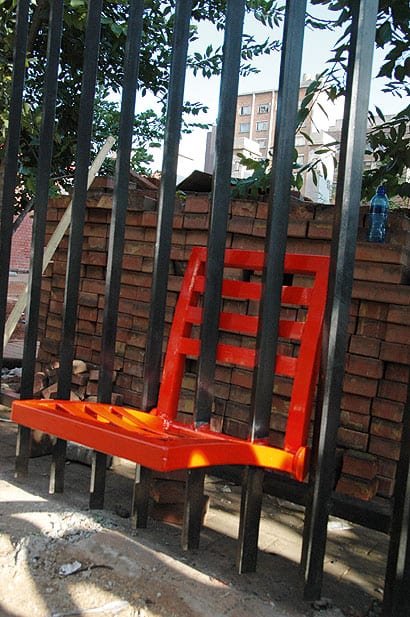|
Straschnow with pieces including the Folding Trestle legs, ChairEasyChair and Folding Table (image: Raoul Kramer/Collective Exposure) |
||
|
“I’m ignored in Holland,” says Amsterdam-based Israeli designer Jair Straschnow. “It’s not that I didn’t try – I came here ten years ago, semi-professional with something to show, but they don’t consider what I do interesting. I’m not part of the gang.” The thing is, at first sight Straschnow’s furniture doesn’t look interesting. The relatively unknown 44-year-old presented his Grassworks collection at the Aram Gallery during the London Design Festival; anyone glancing in might have thought Habitat was using the space for storage. But a closer look at the pieces reveals an innate intelligence. The flat-pack bamboo furniture mostly uses no glue or screws – it simply slots together using various elegant variations on the dovetail joint. It’s a type of minimalism, “but then, not really,” says Straschnow. “I just prefer to make a volume by constructing it from a thin skin rather than cutting a whole block.” He does this partly for environmental reasons but mostly for a bit of a challenge. “For example,” Straschnow says excitedly, “to make a table top with a piece of bamboo just 10mm thick, already I have a problem because 10mm is not strong enough.” His solution is to give the bamboo sheet an upward curve – a downward curve might work but “a table with a belly is the saddest table you’ve ever seen.” The curved surfaces of his table and bookshelves have a structural function, using tension to help hold everything together. But the curves also give the product a degree of flexibility, so its legs can find even ground on a wobbly floor. It’s this kind of consideration that makes Straschnow a good designer. He thinks about the whole picture, from social problems to silly irritants – and makes sure his pieces don’t accommodate them. His picnic table is sliced in half to form a right angle. “If you sit at a bench it’s occupied,” he says. “For the same amount of wood and energy just slice it open and then a few people can use it.” His pragmatic approach made the Grassworks exhibition a word-of-mouth favourite and is the perfect antidote to the narrative-heavy design that occupies the design scene. “It’s my reaction against it,” Straschnow says. “I really don’t like all this exclusive design that you get. It makes me sick. It’s everything I dislike about this thing called ‘design’.” It’s no wonder he hasn’t befriended the Dutch pack that paved the way for limited editions. It’s also not the first time he hasn’t fitted in. Straschnow acts out his principles and left Israel ten years ago following a stint “as a sort of activist,” he says, somewhat flippantly. “I don’t like to go into it much, but I was sitting in jail for refusing to serve in the army. I guess you could say that I’m a socialist.” He now channels his political ethos into his design work, demonstrated best by a project in Johannesburg. Straschnow was invited by an arts organisation to do a project at the Drill Hall, a protected historical site right in the middle of one of the world’s most violent neighbourhoods. It’s a public space, but gated off from a community of immigrants that occupies the surrounding streets, acting as an unofficial pit stop for the hundreds of taxi drivers that pass through. “We opened the site up,” says Straschnow. “The fence, which normally defines the border between inside and outside, is used to diffuse those definitions.” Straschnow removed some fences and illegally interweaved others with metal seating for the public – placing the seats literally on both sides of the fence. A week-long festival, complete with an open-air cinema, attracted “visitors that usually would only drive past with the windows shut”. It worked – the street workers used the public space he’d created for them “and I think it changed a bit of the perspective of some people”, he says. But Straschnow knows the limits of design in the bigger picture: “A few months later there were all these riots and I’m not sure how many mechanics are still standing there – I think most were killed. So, even if you think you have found a small solution for a better life, there are always more complicated things.”
The flat-pack Folding Table, with pre-wraped top (image: Tim Stet)
A fence seat at Drill Hall (image: Tim Stet) |
Words Anna Bates |
|
|
||
|
The eLpicnic table and a seasaw that that adjusts to unequal weights (image: Tim Stet) |
||






















